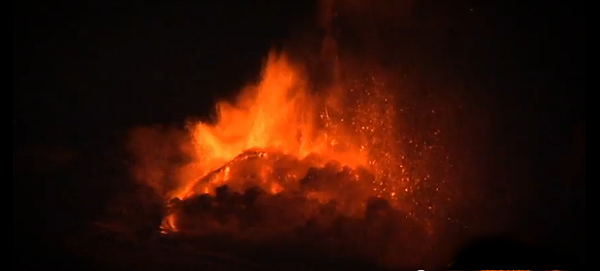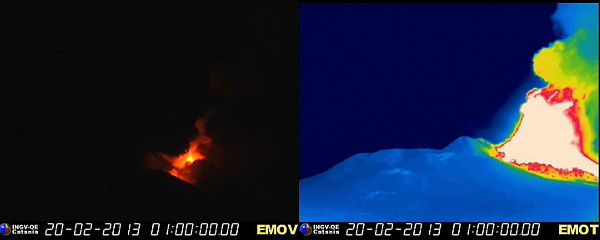Mt. Etna is waking up – new eruption produced lava fountains and lava flows

In the first true paroxysm at Mt.Etna in Italy, after nine months, volcano gave birth to new lava fountains and lava flows from the New SE crater. The strombolian activity rapidly increased and merged into lava fountains on February 19, 2013. INGV Sezione di Catania reported a lava flow reached about 2600 m elevation on the slope north of Sierra Giannicola Picola and descended into Valle del Bove.
 Visible and thermal webcam screenshots show latest activity at 01:00 UTC on February 20, 2013 (Credit: INGV Montagnola)
Visible and thermal webcam screenshots show latest activity at 01:00 UTC on February 20, 2013 (Credit: INGV Montagnola)
A strong phase of strombolian activity took place over night on February 17, 2013 at the New SE crater. The strong strombolian activity started on February 18, 2013 and progressively increased and merged into lava fountains by February 19, 2013. Bellow is the new video released by KdEtna showing fresh eruption on February 19, 2013.

Mt. Etna LIVE WEBCAMS
Mount Etna, towering above Catania, Sicily’s second largest city, has one of the world’s longest documented records of historical volcanism, dating back to 1500 BC. Historical lava flows cover much of the surface of this massive basaltic stratovolcano, the highest and most voluminous in Italy. The Mongibello stratovolcano, truncated by several small calderas, was constructed during the late Pleistocene and Holocene over an older shield volcano. The most prominent morphological feature of Etna is the Valle del Bove, a 5 x 10 km horseshoe-shaped caldera open to the east. Two styles of eruptive activity typically occur at Etna. Persistent explosive eruptions, sometimes with minor lava emissions, take place from one or more of the three prominent summit craters, the Central Crater, NE Crater, and SE Crater (the latter formed in 1978). Flank vents, typically with higher effusion rates, are less frequently active and originate from fissures that open progressively downward from near the summit (usually accompanied by strombolian eruptions at the upper end). Cinder cones are commonly constructed over the vents of lower-flank lava flows. Lava flows extend to the foot of the volcano on all sides and have reached the sea over a broad area on the SE flank.
Sources: INGV Sezione di Catania, VolcanoDiscovery, Global Volcanism Program
Featured image: Youtube screenshot

Commenting rules and guidelines
We value the thoughts and opinions of our readers and welcome healthy discussions on our website. In order to maintain a respectful and positive community, we ask that all commenters follow these rules.